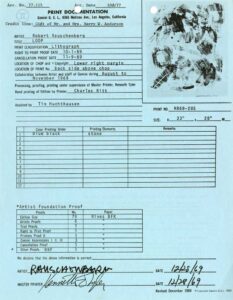Ownership History
Harry W. and Mary Margaret Anderson, purchased 1970
San Francisco Museum of Modern Art, gift of Harry W. and Mary Margaret Anderson, 1977
Exhibition History
Exhibition history not provided for multiples.
Publication History
Robert Rauschenberg, “A ‘Collage’ Comment,” Studio International 178, no. 917 (December 1969): 246–47.
Lawrence Alloway, “The Graphic Art of Robert Rauschenberg,” in Rauschenberg: Graphic Art (Philadelphia: Institute of Contemporary Art, University of Pennsylvania, 1970).
Edward A. Foster, Robert Rauschenberg: Prints 1948/1970 (Minneapolis: Minneapolis Institute of Arts, 1970).
Lawrence Alloway, “Rauschenberg’s Graphics,” Art and Artists 5, no. 6 (September 1970): 20.
Paul Richard, “Apollo 11 as an Art Form,” Washington Post, October 30, 1970.
Robert Hughes, “The Revival of Prints,” Time, January 18, 1971, 56, 57 (ill.).
“Falls Gallery To Exhibit Moon Series,” Buffalo Courier-Express, March 5, 1980.
Mary Lynn Kotz, Rauschenberg, Art and Life (New York: Harry N. Abrams, 1990), 178, 179 (ill.), 251.
Kathleen Slavin, Robert Rauschenberg: A Print Survey in Themes, 1952–1992 (New York: Castelli Gallery, 1992).
Jerry Cullum, “Review: ‘Robert Rauschenberg: A Print Survey in Themes, 1952–1992,’” Atlanta Journal–Constitution, October 23, 1992, (ill.).
J. Richard Gruber and Ann Rowson, Robert Rauschenberg: Major Printed Works, 1962–1995 (Augusta, GA: Morris Museum of Art, 1995), 8–9.
Jeffrey Day, “A Modern Print Master Rauschenberg Exhibit Looks at Enduring Art,” State (Columbia, SC), September 17, 1995.
Christopher Knight, “2001: A Space Oddity,” Los Angeles Times, February 10, 2001.
Jane Kinsman, The Art of Collaboration: The Big Americans (Canberra, Australia: National Gallery of Australia, 2002), 13–15.
Robert Saltonstall Mattison, “Space Exploration Works,” chap. 3 in Robert Rauschenberg: Breaking Boundaries (New Haven, CT: Yale University Press, 2003), 105–66.
Lewis Kachur, Robert Rauschenberg: Transfer Drawings from the 1960s (New York: Jonathan O’Hara Gallery, 2007), 15n18.
Lindsay Christians, “A Country in Conflict—Rauschenberg Prints Capture the 1960s in Sharp Detail,” Wisconsin State Journal (Madison), September 13, 2009.
Jaklyn Babington, Stoned Moon Robert Rauschenberg (Canberra, Australia: National Gallery of Australia, 2010).
Larry Gagosian, James Lawrence, John Richardson, et al., Robert Rauschenberg (New York: Gagosian Gallery, 2010), 12 (ill.), 13.
Rauschenberg at Gemini (Pasadena, CA: Armory Center for the Arts, 2010), 10, 11 (ill.).
This listing documents select references that provide general information about the print. It has been reviewed and is complete as of August 31, 2016.
